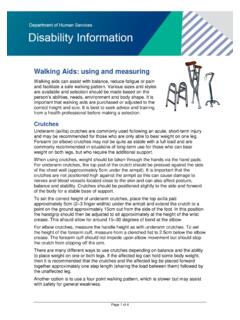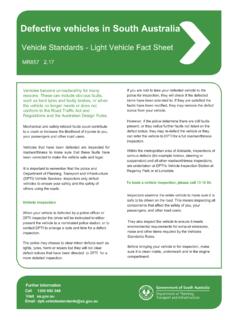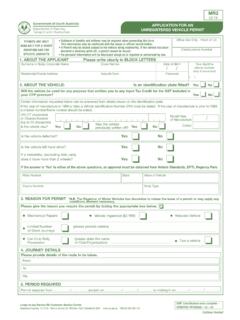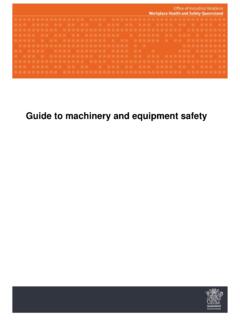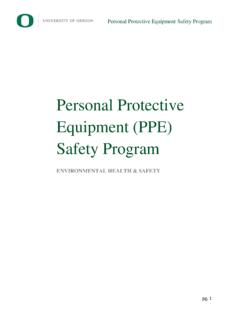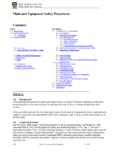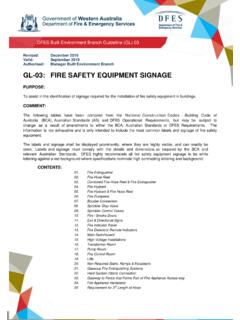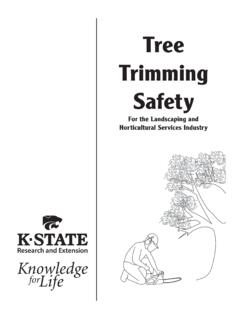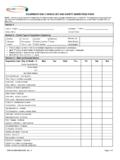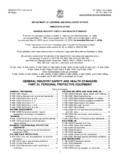Transcription of 4. Safety equipment - South Australia
1 Safety equipment4. Safety equipment What you need and where 42 Categories of South Australian waters 42 Required Safety equipment checklists 43 Variations from standard requirements 44 Recommended equipment 45 Standards and features 45 Anchors 45 Charts and maps 46 Distress flares 46 Emergency position indicating radio beacon (EPIRB) 47 Standards 47 Fire extinguishers 48 Portable Fire Extinguisher Guide 48 Marine radio 49 Miscellaneous Safety equipment standards 50 Lifejackets 50 Tide times 52 All vessels operating in South Australian waters are legally required to carry certain Safety equipment , depending on the vessel s size and type, and where it is being used, for example in the open sea or in a river.
2 For certain types of vessels and activities, it s also required that you wear a lifejacket at all times. Safety equipment must be in good working order readily accessible, and protected from the sea and this chapter there are Safety equipment checklists for all recreational vessel types and uses, and the required standards or features of the equipment42 | South Australian recreational boating Safety handbookWhat you need and whereAs a ready reminder of the Safety equipment you need on board, Safety equipment stickers are available from DPTI by telephoning 1300 183 of South Australian watersSchedule 9 of the Harbors and Navigation Regulations 2009 lists the minimum Safety equipment that you re required to carry in South Australian waters; these waters are defined as being either protected, semi-protected or unprotected. Protected waters all inland waters excluding Lake Albert and Lake Alexandrina and waters influenced by the tide.
3 Semi-protected waters waters inshore of a line 2 nautical miles to seaward of the low water mark of the coast of the mainland or Kangaroo Island, or the banks of Lakes Alexandrina and Albert. Tidal waterways such as the Port Adelaide River and the Coorong are classified as semi-protected waters. Unprotected waters waters offshore of a line 2 nautical miles seaward of the low water mark of the coast of the mainland and Kangaroo Island, or the banks of Lakes Alexandrina and legislation also refers to the waters of Spencer Gulf and Gulf of St Vincent, which are defined as follows. Spencer Gulf the waters north of a line drawn from Cape Catastrophe on Eyre Peninsula to Waterhouse Point on Thistle Island and then to Corny Point on Yorke Peninsula. Gulf of St Vincent the waters north of a line drawn from Troubridge Point on Yorke Peninsula to Rapid Head on Fleurieu line indicates limit of gulf watersSafety equipmentChapter 4.
4 Safety equipment | 43 Required Safety equipment Protected WatersSemi-protected WatersUnprotected WatersVessels less than 8 metres longApproved lifejacket per person ^ Bucket with line attached or bilge pump(s) Fire bucket One approved fire extinguisher (if engine fitted or cooking facilities on board) Anchor and cable Waterproof and buoyant torch Approved compass fitted to the vessel Four litres fresh water Two approved flares and smoke signals Marine radio Paddles/oars (if your vessel is under six metres) Vessels 8 metres long and overApproved lifejacket per person ^ Level 100 or above Level 100 or above Bucket with line attached and bilge pump(s) Fire bucket Two approved fire extinguishers (if engine fitted or cooking facilities on board) Anchor and cable Waterproof and buoyant torch Approved compass fitted to the vessel Four litres fresh water Two approved flares and smoke signals Marine radio Lifebuoy with line Additional equipment for all vessels regardless of length in prescribed unprotected waters : more than three nautical miles from shore, except in inland waters, in Lakes Alexandrina and Albert; or more than five nautical miles from shore in Gulf of St Vincent or Spencer GulfEPIRB (Radio Distress Beacon) V sheet more than ten nautical miles from approved rocket parachute flares Chart of the area of water If your vessel is over 15 metres in length you are required to carry an extra lifebuoy with line and a life raft.
5 * or another type of propulsion # If vessel is under 12 metres, second anchor can be carried as a spare^ specific legislation applies to wearing of lifejackets see table under When to wear a lifejacket Chapter 3 Safety on the Water Level 100 or aboveLevel 100 or aboveif operating at night**two bailerstwo bailersif operating at nighttwotwo #Required Safety equipment checklistsSafety equipment44 | South Australian recreational boating Safety handbookVariations from standard requirementsCertain types of vessels are either partially or totally exempt from the Safety equipment requirements. Those vessels exempted must instead carry the following: Canoes, kayaks, rowboats, or similar small, unpowered vessels in protected or semi-protected waters a lifejacket, Level 100 or higher, 50 or 50S must be worn by each person on board, except when in a rowboat one suitable bailer, unless the hull is permanently enclosed if the vessel is being operated at night, a waterproof and buoyant torch or lantern.
6 Canoes, kayaks, rowboats, or similar small, unpowered vessels in unprotected waters:* an approved lifejacket level 100 or above or level 50 with whistle attached, must be worn at all times by each person on board one suitable bailer, unless the hull is permanently enclosed if the vessel is being operated at night, a waterproof and buoyant torch or lantern one spare paddle V distress sheet one tow line at least 15 m in length and strong enough for the vessel to be towed in any conditions two hand-held red flares and two hand-held orange smoke signals one approved compass fitted to the vessel Approved navigation chart of the area of operation one litre of fresh water one EPIRB. Personal watercraft (PWC) - an approved lifejacket level 50 or 50S must be worn at all PWC may not be operated in unprotected waters. Sailboards or kite boards require: within 400 m of shore a lifejacket Level 100 or higher, 50 or 50S worn at all times more than 400 m from shore a lifejacket level 100 or higher, worn at all times.
7 Surfboards or surf skis in protected waters, an appropriate approved lifejacket, worn at all times. Surf rescue boats propelled by motor, when involved in rescue work within 1500 m of the shoreline or patrol work within 1000 m pair of paddles or oars, or other means of auxiliary propulsion. Surf rescue boats propelled by paddles or oars a bailer attached to the vessel by a lanyard. Tender vessels, while being used in conjunction with another vessel must carry: one pair of paddles or oars, or other means of auxiliary propulsion one bucket, bailer or bilge pump/s to drain each compartment lifejackets must be worn in accordance with requirements for vessel size and area of operation see table under When to wear a lifejacket Chapter 3 Safety on the Water. Waterskiers or people being towed by a vessel in any other way an approved lifejacket Level 50 or 50S worn at all times.* A canoe, kayak, rowboat or similar small, unpowered vessel operating in unprotected waters is exempted from carrying flares, smoke signals, compass, EPIRB or chart of the area, if the vessel is: with at least two other similar vessels, or a support vessel; and at least one of the accompanying vessels is equipped with all listed equipment ; and the exempted vessel remains within 50 m of the fully-equipped vessel at all equipmentChapter 4.
8 Safety equipment | 45 Recommended equipmentVessels longer than 6 metres, auxiliary power such as paddles, oars or a spare motor is strongly every motorised vessel should be equipped or fitted with: a sounding signaling device (horn or whistle) a towing harness and rope an isolating switch emergency steering GPS (valuable to assist navigation, but do not rely on as the sole navigation tool. The units are electrical and batteries can go flat, while maps can be incomplete) first aid and featuresThis section outlines the minimum standards and features your Safety equipment requires to perform as you expect when needed. AnchorsAn anchor is a very important item of equipment and should be selected carefully. Choose an anchor that will suit your circumstances and the area of operation. The most common types are: Danforth recommended for small craft small, light, easy to handle excellent holding power, especially in sand, but may get caught on reefs.
9 Coral quick release (CQR) or plough suited to larger and heavier vessels excellent holding power, but best suited to mud; may get caught on reefs. Grapnel flexible prongs (suitable for anchoring on reefs) suited to snag and rock conditions (for example, the River Murray) though these anchors are fine in South Australia they may not be approved in all states; you should check with local authorities before going boating interstate. SARCA (sand and rock combination anchor) superb holding power multi-purpose suited to mud, sand, gravel and rock bottoms not suited to snags (for example, the River Murray). Sea anchor or drogue (not an approved anchor) this may be anything that can be used for offshore boating to slow drift, eg. a large bucket trailing behind the vesselScope 3:1 Anchor Chain at least 2-3 metres (see text) Sandy Seabed Anchor Bow Roller Bitter End WIND The length of the anchor line is dependent on the depth of the water and the prevailing equipment46 | South Australian recreational boating Safety handbook keeps bow facing into wind and waves a sea anchor or drogue will not hold your vessel fast, so if using a sea anchor you must also carry an approved the following points in selecting the line.
10 Don t use a line that floats, such as polypropylene as it inhibits the anchors ability to dig in and is prone to being cut by other propellers Nylon and silver ropes have strength, stretching ability and resistance to abrasion, and don t easily float in water Nylon is stronger than silver rope The line must be resistant to chafing at the deck lead. For best performance, insert a length of chain between the anchor and line: at least 2 m long, for nylon lines; or at least 3 m long, for other lines All-chain lines are recommended for larger vessels, to increase holding power and absorb and mapsVessels operating more than 10 nautical miles from shore must carry a navigation chart or map of the waters they are navigating. Navigation charts should: be suitable for navigation purposes be up-to-date help the operator plot a course or destination identify navigation features including the location of shipwrecks and other submerged hazards, depth of water, and the location of islands and hidden reefs show details such as navigation beacons and markers to harbours and channel : GPS plotters while useful are not a substitute for a marine flaresFlares are only used in emergencies to attract attention from passing vessels or aircraft, or to pinpoint your position to rescuers.



